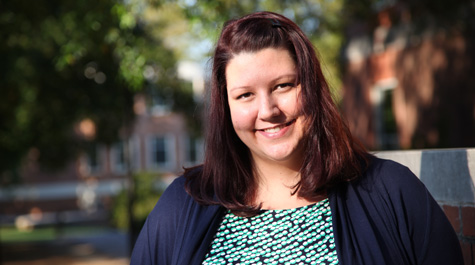New book features W&M librarian
William & Mary librarian Kathleen DeLaurenti has been featured in the book This is What a Librarian Looks Like by Kyle Cassidy, a celebratory tribute to the unsung community heroes. As a music and arts librarian at the W&M Music Library and Open Access Editor for the Music Library Association, DeLaurenti helps people access resources and make their work available to a broader audience.
“Being a librarian means helping put people in touch with the tools and resources they need to explore their creativity and make new knowledge,” said DeLaurenti. “I love helping people think about what kind of impact they want their work to have and then helping them decide about how it will be sold or given away and under what conditions other people can share or reuse it.”
DeLaurenti is just one of almost 220 librarians featured in Cassidy’s book. From brightly-dyed hair and tattoos to collared shirts and bow ties, this photographic montage of librarians from communities across the country gives a new perspective on who librarians are and what they look like – and it’s not the stern, humorless stereotype commonly portrayed in books and films. Librarians around the nation are fighting for patrons who need library resources to live in the modern age of technology. As a part of Cassidy’s project, DeLaurenti has called attention to the challenges music libraries face with collecting and preserving digital music.
“One reason I wanted to participate in the project was to give a face to the issues confronting music libraries,” said DeLaurenti. “We have a separate association and aren’t always part of the conversation with our colleagues in public libraries and even other areas of academic libraries.”
With the rise of digital music, it has become increasingly harder for music libraries to collect and share music, particularly music released through services like iTunes and Tidal, due to ownership rights. DeLaurenti explained that libraries aren’t able to purchase MP3s because they can’t be shared like a CD, which prevents libraries from preserving music for scholars and listeners of the future.
“Many libraries are trying to solve this problem locally by working with artists who haven’t signed big record deals and who are much open to having their music preserved and accessible in their local communities, but we don’t have a solution for making sure that Frank Ocean’s Blonde is in library collections 50 or 100 years from now,” said DeLaurenti.
In addition to highlighting the challenges faced by music libraries, DeLaurenti hopes that readers of Cassidy’s book learn about all of the different ways that librarians support, advocate and impact their communities every day.
“It’s exciting for me to see all of the incredible work my colleagues in special and public libraries are doing that I don’t get to experience every day. As the book points out, librarians definitely aren’t just reading all day!”
 Skip to main content
Skip to main content

